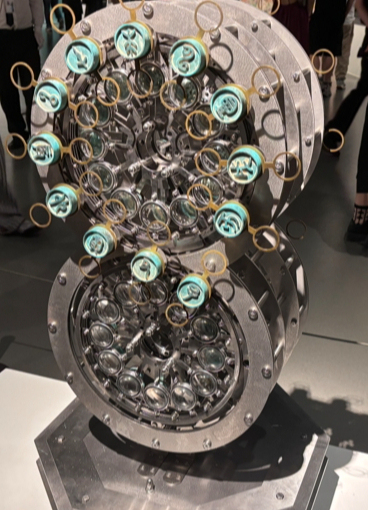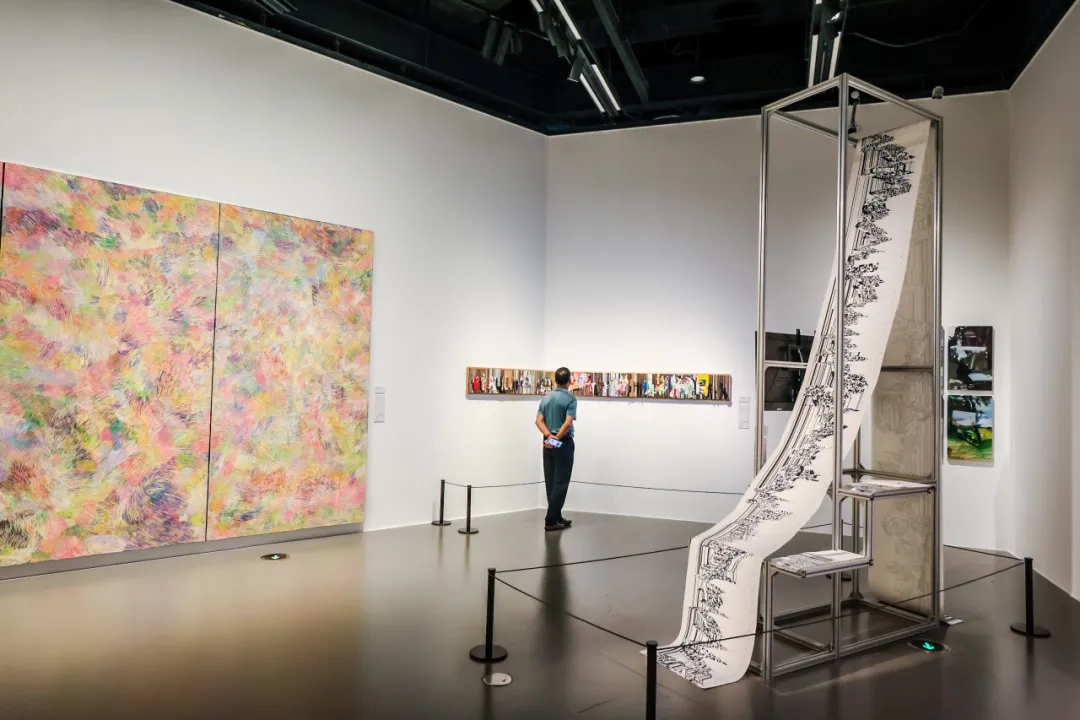
Young artist Nie Shichang's work "Dripping Instrument" at this year's China Academy of Art graduation exhibition attracted huge attention, with many visitors making special trips to check it out. The Paper reports that the work, which debuted in Shanghai yesterday, is also on display alongside another work by Nie Shichang, "Sixty Instruments."
On September 13, "Machine Intelligence: The 18th Shanghai Youth Art Exhibition" officially opened at the Liu Haisu Art Museum in Shanghai. Set against the backdrop of the development of artificial intelligence, the exhibition focuses on the new possibilities of art in the context of human-machine symbiosis.
The 18th Shanghai Youth Art Exhibition, titled "Machine · Intelligence," is fittingly timely—"machine" refers to the surging algorithms of our time, while "intelligence" represents the untamed imagination and critical thinking of youth. The curatorial team stated, "Amidst the global revolution in algorithm-based AI technology, we urgently need to explore the diverse possibilities of human artistic creativity, imagination, and resilience."
Zhang Zikang, former director of the Central Academy of Fine Arts Art Museum, said: "Today's young people are really active. They use various visual arts to express the present and their understanding of the future, which is very inspiring to us."

Exhibition site
Integrating technology to face the artistic transformation in the AI era
A six-foot-long arc-shaped installation silently rotates in the center of the Liu Haisu Art Museum in Shanghai. Its front is engraved with the Earthly Branches and the Chinese zodiac, while its back features the Heavenly Stems and numbers. Its trajectory symbolizes the endless and repetitive nature of time. Young artist Nie Shichang's "Sixty Instruments" serves as a metaphor for the 18th Shanghai Youth Art Exhibition: in an era of sweeping artificial intelligence, artistic creation is seeking a new balance between tradition and innovation, between humans and machines.

Nie Shichang's Sixty Rites

The Dripping Meter
The "Dripping Instrument," exhibited on the third floor of Building D at C·PARK Haisu Cultural Plaza, is inspired by the traditional Chinese compass and incorporates the ripples of a water drop. "The center of the compass is the Tai Chi symbol, and radiating outward in circles are the eight trigrams, nine stars, twenty-four solar terms, and sixty-four hexagrams, just like the ripples of a water drop."
Artist Nie Shichang explained: "The center of the compass is the Tai Chi symbol, and spreading outward in circles are the eight trigrams, nine stars, twenty-four solar terms, sixty-four hexagrams, etc., just like ripples spreading out from water droplets." He said that "Sixty Instruments" expresses the endless and cyclical nature of time, and the "Didong Instrument" embodies the idea in classical culture that "one gives birth to two, two gives birth to three, and three gives birth to all things."
Su Yongjian's installation work, "The Silk Thread of Life," features a simple silk-spinning device with a timer counting down to one thousand hours, or 3,600,000 seconds. "When the seconds reach zero, the spinning will cease, and the motor will completely wear out, marking the end of the work."
"Crossing the Paintings - Visualization of Information Distortion of the Images of the Seventy-Two Sages of Confucius" uses infographics to present the historical coordinate axis of the seventy-two sages, and "Useful Temperature" shows a robotic arm made of fiber material trying to weave a scarf.

Exhibition site
According to the organizers, the exhibition also launched a number of innovative initiatives. For the first time, it cooperated with the subway to create an art train on Shanghai Line 4, integrating art into the city's public space; launched the "YoungV Short Video Plan" to showcase the artists' creative ecology in the form of selfies and follow-up shots; adopted the "expert review + public voting" mechanism, and expanded interactive communication through platforms such as Xiaohongshu; and jointly established an offline recording studio with the Xiaoyuzhou App, inviting guests and audiences to participate in podcast recording.
The exhibition also abandons the traditional centerline alignment rule, adopting an upper or lower alignment method, so that the works of varying sizes are staggered in height, creating a "jumping" feeling in the exhibition hall. This exhibition method complements the freshness and vitality of the young artists' works.
Young Artists and Their Reflections on the Digital Age
It is reported that all the artists participating in this exhibition were born after January 1, 1980, and are a generation that truly grew up in the information age and immersed in a technological environment.
In terms of curatorial approach, the exhibition also invited 15 young curators from all walks of life and different age groups for the first time. They will not only participate in the early planning, but will also "take center stage" and play an important role in every aspect of the exhibition, injecting fresh and diverse youth perspectives and innovative energy into the exhibition. Artist Li Zhengzhong, who participated in the Youth Art Exhibition as a curator for the first time, said: "Faced with thousands of works at once, I have to examine them one by one, while considering which ones are suitable for display in the exhibition hall and which ones can represent the youth of our generation. Each of the 15 young curators has their own areas of expertise and focus, which will make this exhibition very diverse. This experience is a pressure for me, but also an honor."

Exhibition site
Curator Lu Junyi said: "Young artists' perspectives are novel and diverse. On the one hand, they bring brand-new creativity. On the other hand, young artists also express their ideas in a fusion of innovative ways, such as traditional ink painting."
The exhibition reportedly received 4,060 submissions from young artists from home and abroad, with over 380 works ultimately on display. This represents a record number of submissions since the Liu Haisu Art Museum's new location resumed hosting this branded exhibition. Beyond traditional graphic painting and sculpture installation, the exhibition exhibits a significant diversification trend, encompassing emerging art genres such as new media imaging, experimental photography, art design, digital art (including AI-generated art, algorithmic art, and virtual reality art), trendy art (such as trendy toy design and street art derivatives), and cross-media installation.

Exhibition site
The Shanghai Youth Art Exhibition, founded in 1980 during the early years of reform and opening up, has traversed the past 45 years, its trajectory profoundly bearing the mark of the exploration and growth of Chinese contemporary art. A look at the list of selected and award-winning artists from past exhibitions reveals over a thousand familiar names in the art world, including Yu Xiaofu, Ding Yi, Qiu Ruimin, Zhou Changjiang, Cai Guoqiang, Zhang Enli, and Yang Fudong. All of them achieved notoriety at the Youth Art Exhibition, becoming pillars of artistic creation and even going on to shine globally, radiating their talents on the international art stage.

Exhibition site


